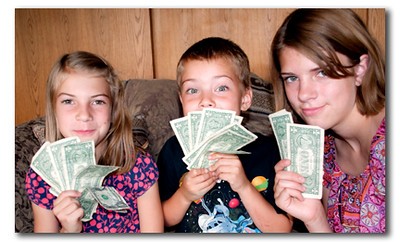Teaching Kids About Money, Part 3
 Building on "Teaching Kids About Money, Part 1" and "Part 2," the following practical ideas can be considered:
Building on "Teaching Kids About Money, Part 1" and "Part 2," the following practical ideas can be considered:
Money games for pre-schoolers to help them learn the worth of money:
- Take file cards and trace around coins. The child can try to fit coins into the spots. Make cards in which the value is explained. One traced nickel equals five traced pennies, one dime equals two traced nickels, and so on. (This is a tough concepts for youngins, since the dime is smaller than a nickel but worth more.)
Note: children like handling coins. Do so for a short time. Do not do it until they lose interest. And do not do it around littles who put them in their mouths. Older children can play with these cards on a tray or box lid to keep it out of reach of younger siblings.
- Use coins to do a one-to-one correspondence where they can buy snacks at snack time. For example, "Ants on a Log" snack. The child might give a quarter for the banana, a nickel for the peanut butter, and a penny for each raisin. One-to-one correspondence helps the child learn that we use money for an exchange: give the piece of money, get a thing in return.
- A similar idea can be done with pretend money and a play store or market. They can count and give change. (There is so much math in learning about money!) They will probably charge more for bigger objects, for that is what makes sense to a preschooler. A toy cash register could be fun for this play. It is not necessary, but it is fun, because it is like what they see at the grocery.
Money for older kids:
- As they get older, you may choose to give a child an allowance. This is money given each week, just for being in the family. You may also choose to give them chores, some of which may be regular tasks that everyone is responsible for while other chores may be things for which they get paid.
- Eventually, you may want to teach them a barter system, exchanging item for item or even exchanging service for service. For example, "If you make my bed, I'll do one of your chores."
- If you're in a situation where a child is wasting your time, a natural consequence might be for that amount of time back in the form of them helping you with something.
- In the older version of the movie "Cheaper By the Dozen," where the father is an efficiency expert, he holds a family meeting at which the children bid on jobs. He takes the lowest bid.
- Extra projects are given extra pay because they are out of the norm. If, at a later point, a child does not want to do the paid extra chore, it might be exchanged with a sibling who would, again, exchange with them at a later date.
- Create a "store" where they can spend their chore money. Stock it with items you have bought which you can sell to your kids (though for much cheaper than market price!).
- For older children, the game Monopoly deals with using money.
A Few Cautions:
- It is important to keep these things in balance and take care that we are not teaching obsession with money.
- Also, as soon as a child is able to understand, it must be taught that credit cards are not magical money for free. At the very latest, children should be taught about credit cards at the end of high school, for they will be targeted at college orientation. If this is neglected, they may end up with ruined credit and a lot of debt. The basic principle to teach here is this:
Do not spend more money than you have.
Four Essentials Before Learning About Money:
- A sense of one-to-one correspondence.
- They can number in order.
- As the numbers go up, that means more. Each number stands for a certain amount.
- When counting items, the last number is the amount that there are. The total. "1, 2, 3, 4. There are 4."
Three books for Teaching Kids About Money:
- Bunny Money, by Rosemary Wells. It is fun, creative, and has play money in it.
- I Can Name Bills and Coins, by Rebecca Wingard-Nelson. It has pictures of real money in it.
- A Dollar, A Penny, How Much and How Many, by Brian T. Cleary. It has rhymes and fun pictures.
Photo Credit: Carissa Rogers cc
Related Posts
By accepting you will be accessing a service provided by a third-party external to https://mail.growthandgiggles.com/

